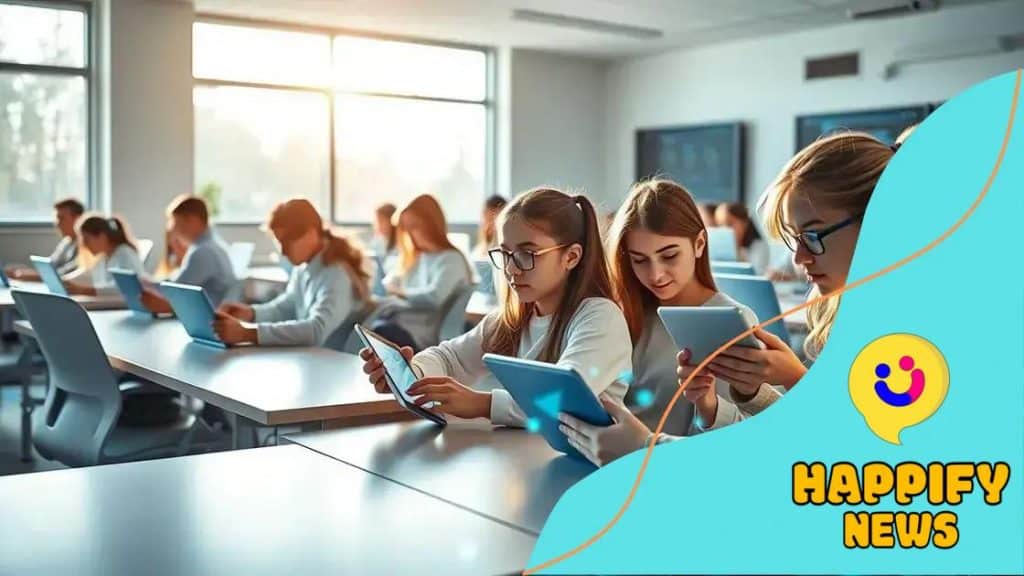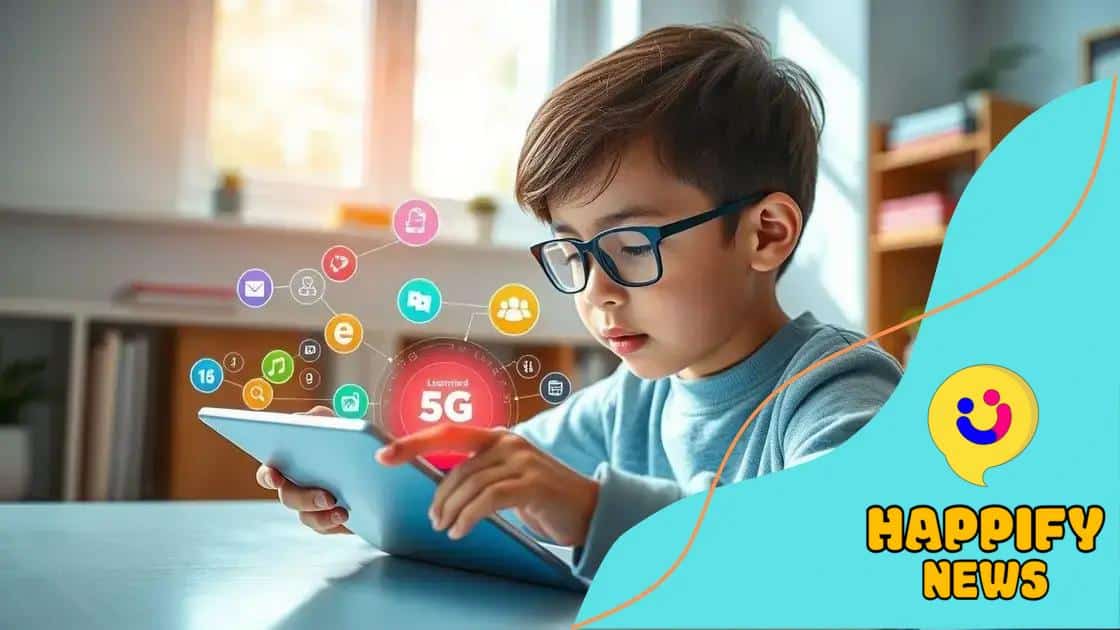5G’s impact on education: transforming the learning landscape

Anúncios
5G’s impact on education revolutionizes learning through enhanced connectivity, personalized learning experiences, and access to innovative tools like VR and AR, while also addressing challenges such as infrastructure costs and equitable access.
The advent of 5G’s impact on education is undeniable. As higher speeds and improved connectivity become prevalent, learning environments are evolving rapidly. Are we ready for this transformation?
Anúncios
Understanding 5G technology
Understanding 5G technology is essential to grasp its potential impact on education. This next generation of wireless technology promises faster speeds, lower latency, and greater connectivity than ever before.
5G allows for improved mobile broadband capabilities, which can enhance the learning experience in various ways. For instance, students can access high-definition video streaming for their lessons without interruptions. This makes complex topics easier to understand and keeps students engaged.
Key features of 5G technology
There are several remarkable features of 5G technology that set it apart:
Anúncios
- High Speed: 5G networks are expected to be up to 100 times faster than 4G.
- Low Latency: This means quicker response times, essential for real-time applications like online classrooms.
- Increased Capacity: 5G can support many more devices on the same network, ideal for crowded classrooms.
- Enhanced Connectivity: Greater reliability allows for seamless integration of smart devices.
These features together create an exciting opportunity for educators and students alike. For example, teachers can implement virtual reality (VR) lessons that would previously have been impossible to execute due to bandwidth limitations. The use of 5G can also empower students to collaborate more effectively, whether they are in the same room or across the globe.
As schools and learning environments adapt to incorporate 5G technology, they will need to consider the infrastructure required to support this advancement. Schools must invest in new tools and training to make the most of what 5G has to offer.
There is no doubt that 5G technology will revolutionize the educational landscape. By understanding its foundations, we can better prepare for the future of learning.
How 5G enhances remote learning
One of the most exciting aspects of 5G technology is how it enhances remote learning. With ultra-fast internet speeds and low latency, students can enjoy an immersive educational experience from the comfort of their homes.
Remote learning can often feel disconnected, but 5G bridges that gap. Students can participate in live classes with minimal lag, allowing for real-time communication with teachers and peers. This immediate feedback loop fosters a more engaging learning environment.
Benefits of 5G in remote education
Some of the main benefits of 5G for remote learning include:
- Improved Connectivity: With better network coverage, students in rural areas can access quality education.
- Seamless Video Conferencing: High-definition video streams make online classes more interactive.
- Collaborative Tools: Enhanced collaboration platforms allow students to work together easily, no matter where they are.
- Access to Resources: Quick downloads and uploads mean students can access and share educational materials without delays.
By using tools that require higher bandwidth, like virtual reality simulations, teachers can create engaging lessons that transport students to different environments or historical events. This not only makes learning fun but also deepens understanding by placing students in immersive situations.
Moreover, 5G can support more devices in a single household, which is crucial for families with multiple learners. Everyone can join remote classes, collaborate on projects, or engage in extracurricular activities without worrying about slow connections or dropped signals.
As education becomes increasingly digital, the role of 5G in remote learning continues to grow. By enabling stronger connections and more dynamic interactions, this technology shapes a new era of education.
5G’s role in personalized education

5G’s role in personalized education is transforming how students learn and interact with educational content. With its high speed and low latency, 5G allows for tailored learning experiences that cater to each student’s needs.
Personalized education adapts lessons based on a student’s unique strengths and weaknesses. 5G enables data analytics to quickly assess student performance and offer insights. This helps teachers identify areas where students may need extra help, allowing for more focused instruction.
Benefits of personalized learning with 5G
The integration of 5G technology in personalized education offers several advantages:
- Adaptive Learning Platforms: These platforms use real-time data to adjust lessons according to each learner’s progress.
- Instant Feedback: Students receive immediate responses to their work, helping them understand mistakes and learn more effectively.
- Customized Learning Paths: Educators can design lessons that fit individual learning styles and paces, increasing student engagement.
- Resource Availability: 5G allows students to access a wide range of learning materials, including videos, articles, and interactive simulations, anytime and anywhere.
This immediate connectivity enables immersive educational experiences. For instance, students can engage in virtual field trips or use augmented reality (AR) tools that align with their personalized learning goals. Such features make education not only interactive but also relevant to the interests of each student.
Furthermore, teachers can track progress efficiently with integrated 5G tools. The ability to analyze student data quickly means that instructors can refine their teaching methods and provide targeted support when needed, fostering a more effective learning environment.
The opportunities created by 5G for personalized education are vast. As technology continues to advance, the ability to deliver customized educational experiences that meet individual needs will become the standard in academic settings.
Challenges of integrating 5G in schools
While the benefits of 5G technology in education are substantial, several challenges come with its integration into schools. These obstacles can affect how effectively schools can adopt and benefit from this new technology.
One major challenge schools face is the financial cost associated with upgrading infrastructure. Many schools may not have the budget to invest in new equipment, such as routers and devices that support 5G connectivity. This can lead to an uneven landscape where only some students have access to the advantages of this technology.
Implementation hurdles
Successfully integrating 5G into learning environments requires careful planning. Some of the key implementation hurdles include:
- Infrastructure Needs: Schools need to upgrade their physical facilities to support 5G, which may require significant investment.
- Training for Staff: Teachers and administrative staff may need training to effectively use new tools and technologies introduced by 5G.
- Equity in Access: Ensuring that all students have equal access to 5G tools is essential, especially in underfunded schools.
- Technical Support: Schools will require ongoing technical support to maintain and troubleshoot new 5G systems.
Moreover, there are concerns about health and safety related to 5G technology. Some parents and community members may worry about the potential effects of increased radiofrequency exposure from more mobile towers being installed in and around schools. Addressing these concerns through education and transparency is crucial for gaining community support.
The complexity of managing data privacy and security in a more connected environment also poses a challenge. With more devices online, schools must ensure that student information is protected from potential breaches and misuse.
As schools explore the potential of 5G technology, they must navigate these challenges thoughtfully. By doing so, they can fully harness the power of 5G to create enriched learning environments for their students.
Future trends in education with 5G
The future of education with 5G technology looks promising and innovative. As schools adopt this advanced connectivity, new trends will emerge, shaping how students learn and interact.
With the ability to connect more devices simultaneously, classrooms will become smart environments. This means that smart boards, tablets, and other devices will work together seamlessly, making lessons more engaging. For instance, teachers will be able to share real-time information and provide interactive lessons that adjust to students’ needs.
Emerging technologies
Several emerging technologies powered by 5G will transform education:
- Virtual Reality (VR): Students will explore different worlds and historical events through immersive VR experiences during lessons.
- Augmented Reality (AR): Interactive AR tools will allow students to visualize complex concepts, enhancing understanding and retention.
- Artificial Intelligence (AI): AI will analyze student data to provide personalized learning paths tailored to individual strengths.
- IoT Devices: Connected devices will help track student engagement and boost collaboration between peers.
These innovations will lead to a more personalized learning experience. With 5G, students will have access to a vast array of resources at their fingertips. They can collaborate with peers worldwide and participate in projects without the barriers of distance.
Moreover, teachers will have more tools to create dynamic lesson plans. They can incorporate multimedia elements easily, making lessons appealing and inclusive. 5G will also facilitate professional development for educators by providing access to online training and resources that enhance their teaching methods.
As educational institutions embrace these future trends, they will need to focus on implementing necessary infrastructure and training programs. By doing so, they can ensure that both teachers and students are equipped to take full advantage of 5G technology in the classroom.
In conclusion, the impact of 5G technology on education is profound. It paves the way for personalized learning, enhances remote education, and brings innovative tools into classrooms. As schools adapt, they will face challenges such as funding and infrastructure needs. However, the future looks bright as 5G can transform the learning experience, making it more engaging and effective for all students. By embracing these changes, educators can prepare students for a tech-savvy future.
FAQ – Frequently Asked Questions about 5G’s Impact on Education
What are the benefits of 5G technology in education?
5G technology enhances educational experiences through faster internet speeds, improved connectivity, and access to innovative tools like VR and AR.
How does 5G support personalized learning?
5G enables adaptive learning platforms that tailor education to individual student needs, providing instant feedback and customized learning paths.
What challenges do schools face when integrating 5G?
Schools face challenges such as funding for infrastructure upgrades, the need for staff training, and ensuring equitable access for all students.
How will 5G change remote learning?
With 5G, remote learning will become more interactive and engaging, allowing for high-quality video conferencing and access to resources without delays.






